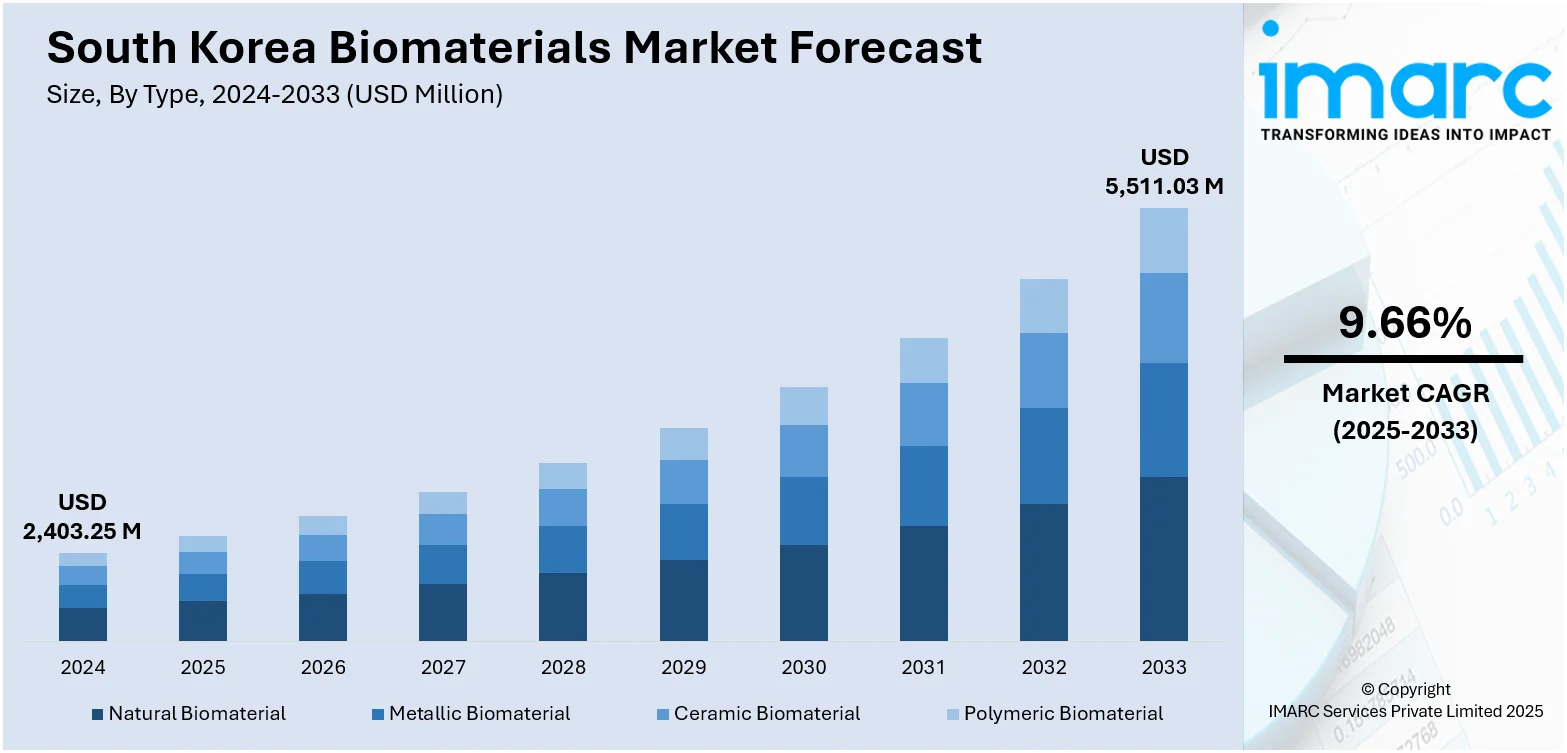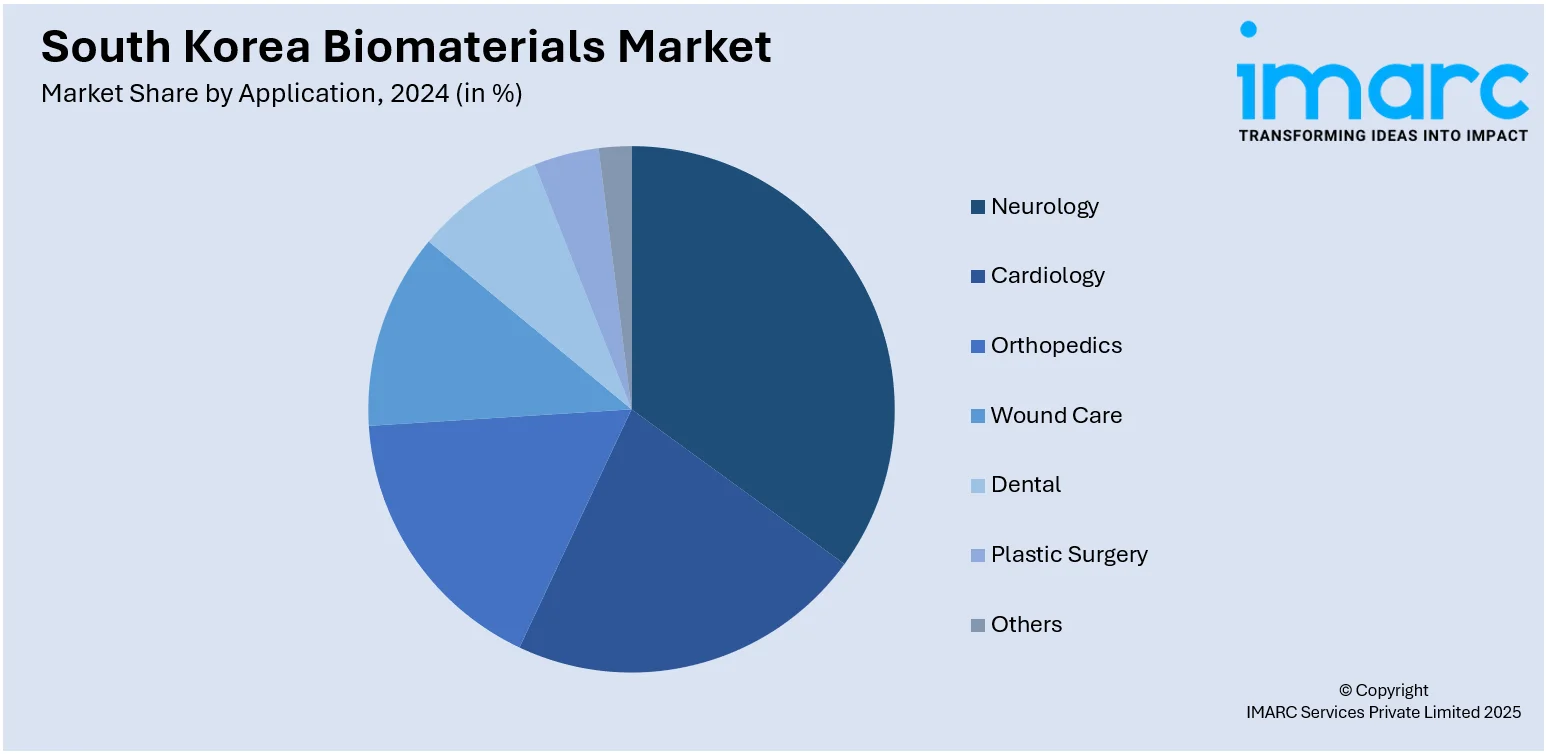
South Korea Biomaterials Market Size, Share, Trends and Forecast by Type, Application, and Region, 2025-2033
South Korea Biomaterials Market Overview:
The South Korea biomaterials market size reached USD 2,403.25 Million in 2024. Looking forward, IMARC Group expects the market to reach USD 5,511.03 Million by 2033, exhibiting a growth rate (CAGR) of 9.66% during 2025-2033. The biomaterials market in South Korea is growing because of advancements in healthcare, medical applications, and the rising demand for specialized treatments due to an aging population. Additionally, the biotech industry's expansion, supported by strong research and innovation that requires advanced biomaterials in medical and clinical applications is increasing the South Korea biomaterials market share.
|
Report Attribute
|
Key Statistics
|
|---|---|
|
Base Year
|
2024
|
|
Forecast Years
|
2025-2033
|
|
Historical Years
|
2019-2024
|
| Market Size in 2024 | USD 2,403.25 Million |
| Market Forecast in 2033 | USD 5,511.03 Million |
| Market Growth Rate 2025-2033 | 9.66% |
South Korea Biomaterials Market Trends:
Advances in Healthcare and Medical Applications
The biomaterials market in South Korea is greatly influenced by progress in healthcare and medical uses, especially as the demand for improved therapies rises. Biomaterials are vital in medical devices, tissue engineering, and regenerative medicine, as their integration progresses owing to the nation's strong healthcare infrastructure and dedication to advanced technology. The rapidly growing aging population in South Korea is catalyzing the demand for specialized medical care and cutting-edge biomaterials. As per the 2024 Statistics on the Aged, people aged 65 and above constitute 19.2% of the population, a percentage projected to exceed 20% by 2025 and hit 30% by 2036. This change in demographics requires the creation of enhanced biomaterials for surgical uses, prosthetic devices, and implants. Advancements in biocompatibility, biodegradability, and mechanical characteristics of biomaterials are essential for enhancing the efficacy of these therapies. Furthermore, rising number of studies on biodegradable implants are transforming post-surgical healing and lowering complication risks in older patients. With healthcare expenditure on the rise, South Korea is placing greater emphasis on integrating biomaterials into essential medical therapies to address the increasing demands of its aging demographic. The ongoing emphasis on improving patient results, combined with rising investments in healthcare infrastructure, is bolstering the South Korea biomaterials market growth.

To get more information on this market, Request Sample
Expansion of the Biotech Industry
With the nation establishing itself as a worldwide leader in biotechnology, it takes advantage of robust research capabilities, a vast talent pool, and an emphasis on innovative solutions. The thriving biotech industry is making substantial investments in biomaterials to enhance progress in drug development, tissue regeneration, and cellular therapies. These advancements frequently rely on biomaterials, including regulated drug delivery systems and biocompatible frameworks for cellular development, to attain enhanced therapeutic results. With the ongoing growth of the biotech sector, the need for advanced biomaterials increases, particularly in research and clinical uses. The link between biotechnology and biomaterials cultivates opportunities for collaborations across industries and technology exchanges, fostering further growth. In 2024, President Yoon Suk Yeol revealed intentions for South Korea to boost its biotechnology sector's production five times, achieving $149 billion by 2035, up from $43 trillion in 2020. This bold estimate included a diverse array of biopharmaceutical products, medical devices, supplements, biomass, and biotechnology services, emphasizing the industry's potential. As these initiatives progress, the incorporation of biomaterials into biotech-led innovations remains vital for the advancement of new medical technologies and therapies, guaranteeing the development of both the biotech and biomaterials sectors in South Korea.
South Korea Biomaterials Market Segmentation:
IMARC Group provides an analysis of the key trends in each segment of the market, along with forecasts at the country and regional levels for 2025-2033. Our report has categorized the market based on type and application.
Type Insights:
- Natural Biomaterial
- Metallic Biomaterial
- Ceramic Biomaterial
- Polymeric Biomaterial
The report has provided a detailed breakup and analysis of the market based on the type. This includes natural biomaterial, metallic biomaterial, ceramic biomaterial, and polymeric biomaterial.
Application Insights:

- Neurology
- Cardiology
- Orthopedics
- Wound Care
- Dental
- Plastic Surgery
- Others
A detailed breakup and analysis of the market based on the application have also been provided in the report. This includes neurology, cardiology, orthopedics, wound care, dental, plastic surgery, and others.
Regional Insights:
- Seoul Capital Area
- Yeongnam (Southeastern Region)
- Honam (Southwestern Region)
- Hoseo (Central Region)
- Others
The report has also provided a comprehensive analysis of all the major regional markets, which include Seoul Capital Area, Yeongnam (Southeastern Region), Honam (Southwestern Region), Hoseo (Central Region), and others.
Competitive Landscape:
The market research report has also provided a comprehensive analysis of the competitive landscape. Competitive analysis such as market structure, key player positioning, top winning strategies, competitive dashboard, and company evaluation quadrant has been covered in the report. Also, detailed profiles of all major companies have been provided.
South Korea Biomaterials Market News:
- In December 2024, South Korea announced a five-year plan to develop 100 advanced industry materials, including 10 biomaterials, to boost domestic capabilities in key sectors. Led by the Ministry of Science and ICT, the initiative aimed to reduce reliance on imports and strengthen supply chains.
South Korea Biomaterials Market Report Coverage:
| Report Features | Details |
|---|---|
| Base Year of the Analysis | 2024 |
| Historical Period | 2019-2024 |
| Forecast Period | 2025-2033 |
| Units | Million USD |
| Scope of the Report |
Exploration of Historical Trends and Market Outlook, Industry Catalysts and Challenges, Segment-Wise Historical and Future Market Assessment:
|
| Types Covered | Natural Biomaterial, Metallic Biomaterial, Ceramic Biomaterial, Polymeric Biomaterial |
| Applications Covered | Neurology, Cardiology, Orthopedics, Wound Care, Dental, Plastic Surgery, Others |
| Regions Covered | Seoul Capital Area, Yeongnam (Southeastern Region), Honam (Southwestern Region), Hoseo (Central Region), Others |
| Customization Scope | 10% Free Customization |
| Post-Sale Analyst Support | 10-12 Weeks |
| Delivery Format | PDF and Excel through Email (We can also provide the editable version of the report in PPT/Word format on special request) |
Key Questions Answered in This Report:
- How has the South Korea biomaterials market performed so far and how will it perform in the coming years?
- What is the breakup of the South Korea biomaterials market on the basis of type?
- What is the breakup of the South Korea biomaterials market on the basis of application?
- What is the breakup of the South Korea biomaterials market on the basis of region?
- What are the various stages in the value chain of the South Korea biomaterials market?
- What are the key driving factors and challenges in the South Korea biomaterials market?
- What is the structure of the South Korea biomaterials market and who are the key players?
- What is the degree of competition in the South Korea biomaterials market?
Key Benefits for Stakeholders:
- IMARC’s industry report offers a comprehensive quantitative analysis of various market segments, historical and current market trends, market forecasts, and dynamics of the South Korea biomaterials market from 2019-2033.
- The research report provides the latest information on the market drivers, challenges, and opportunities in the South Korea biomaterials market.
- Porter's five forces analysis assist stakeholders in assessing the impact of new entrants, competitive rivalry, supplier power, buyer power, and the threat of substitution. It helps stakeholders to analyze the level of competition within the South Korea biomaterials industry and its attractiveness.
- Competitive landscape allows stakeholders to understand their competitive environment and provides an insight into the current positions of key players in the market.
Need more help?
- Speak to our experienced analysts for insights on the current market scenarios.
- Include additional segments and countries to customize the report as per your requirement.
- Gain an unparalleled competitive advantage in your domain by understanding how to utilize the report and positively impacting your operations and revenue.
- For further assistance, please connect with our analysts.
 Request Customization
Request Customization
 Speak to an Analyst
Speak to an Analyst
 Request Brochure
Request Brochure
 Inquire Before Buying
Inquire Before Buying




.webp)




.webp)












